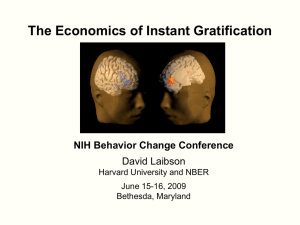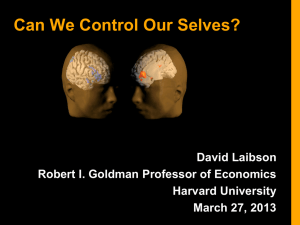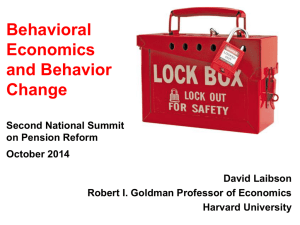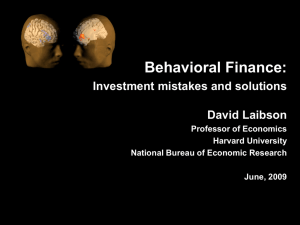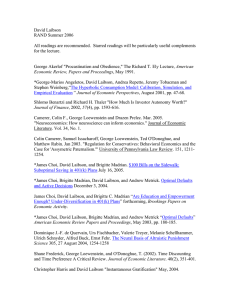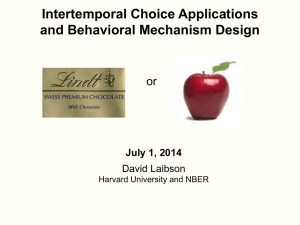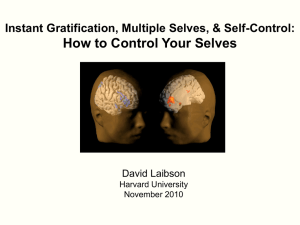Document
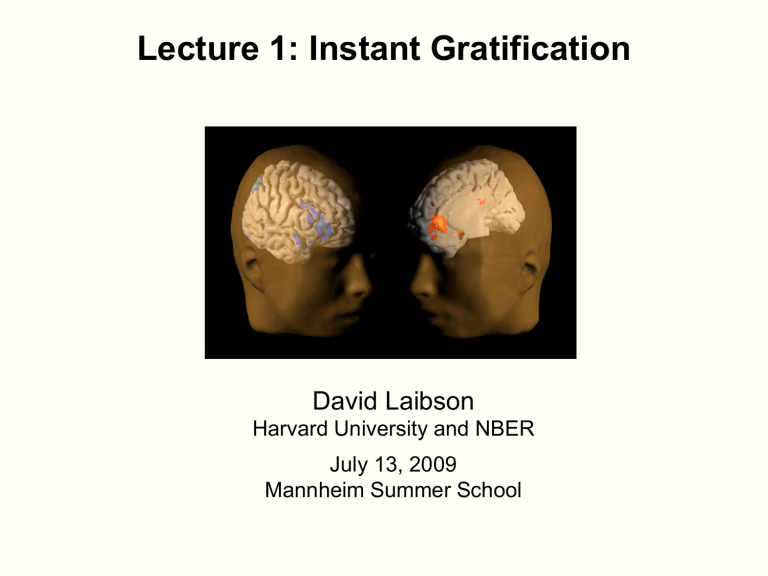
Lecture 1: Instant Gratification
David Laibson
Harvard University and NBER
July 13, 2009
Mannheim Summer School
1. Motivating Experiments
A Thought Experiment
Would you like to have
A) 15 minute massage now or
B) 20 minute massage in an hour
Would you like to have
C) 15 minute massage in a week or
D) 20 minute massage in a week and an hour
Read and van Leeuwen (1998)
Choosing Today Eating Next Week
Time
If you were deciding today , would you choose fruit or chocolate for next week ?
Patient choices for the future:
Choosing Today
Today , subjects typically choose fruit for next week .
Eating Next Week
74% choose fruit
Time
Impatient choices for today:
Choosing and Eating
Simultaneously
Time
If you were deciding today , would you choose fruit or chocolate for today ?
Time Inconsistent Preferences:
Choosing and Eating
Simultaneously
Time
70% choose chocolate
Read, Loewenstein & Kalyanaraman (1999)
Choose among 24 movie videos
• Some are “low brow”: Four Weddings and a Funeral
• Some are “high brow”: Schindler’s List
• Picking for tonight: 66% of subjects choose low brow.
• Picking for next Wednesday: 37% choose low brow.
• Picking for second Wednesday: 29% choose low brow.
Tonight I want to have fun… next week I want things that are good for me.
Extremely thirsty subjects
McClure, Ericson, Laibson, Loewenstein and Cohen (2007)
• Choosing between, juice now or 2x juice in 5 minutes
60% of subjects choose first option.
• Choosing between juice in 20 minutes or 2x juice in 25 minutes
30% of subjects choose first option.
• We estimate that the 5-minute discount rate is 50% and the “long-run” discount rate is 0%.
• Ramsey (1930s), Strotz (1950s), & Herrnstein (1960s) were the first to understand that discount rates are higher in the short run than in the long run.
Self-regulation
Ariely and Wertenbroch (2002)
Three proofreading tasks: "Sexual identity is intrinsically impossible," says Foucault; however, according to de
Selby[1], it is not so much sexual identity that is intrinsically impossible, but rather the dialectic, and some would say the satsis, of sexual identity. Thus, D'Erlette[2] holds that we have to choose between premodern dialectic theory and subcultural feminism imputing the role of the observer as poet.
• Evenly spaced deadlines. [$20 earnings]
• Self-imposed deadlines -- subjects can adopt costly deadlines ($1/day) and most did so. [$13 earnings]
• End deadline. [$5 earnings]
Conceptual Outline
First lecture
• People are not internally consistent decision-makers
• Internal conflicts can be modeled and measured
• Scalable, inexpensive policies can transform behavior
Second lecture:
• Early understanding of neural foundations
Detailed Outline For Lecture 1
1. Motivating experimental evidence
2. Theoretical framework
3. Field evidence
4. Policy
A copy of these slides will soon be available on my Harvard website.
2. Theoretical Framework
• Classical functional form: exponential functions.
D(t) = d t
D(t) = 1, d, d 2 , d 3 , ...
U t
= u t
+ d u t+1
+ d 2 u t+2
+ d 3 u t+3
+ ...
• But exponential function does not show instant gratification effect.
• Discount function declines at a constant rate.
• Discount function does not decline more quickly in the short-run than in the long-run.
1
Exponential Discount Function
Constant rate of decline
0
1 11 21 31
Week (time = t)
41
-D'(t)/D(t) = rate of decline of a discount function
Exponential Hyperbolic
51
Discount Functions
Slow rate of decline in long run
Rapid rate of decline in short run
1
0
1 11 21
Week
31
Exponential
41
Hyperbolic
51
An exponential discounting paradox.
Suppose people discount at least 1% between today and tomorrow.
Suppose their discount functions were exponential.
Then 100 utils in t years are worth 100*e (-0.01)*365*t utils today.
• What is 100 today worth today?
• What is 100 in a year worth today?
100.00
2.55
• What is 100 in two years worth today? 0.07
• What is 100 in three years worth today? 0.00
An Alternative Functional Form
Quasi-hyperbolic discounting
(Phelps and Pollak 1968, Laibson 1997)
U t
= u t
U t
= u t
D(t) = 1, bd, bd 2 , bd 3 , ...
+ bd u
+ b [d u t+1 t+1
+ bd 2 u
+ d 2 u t+2 t+2
+ bd 3 u t+3
+ d 3 u t+3
+ ...
+ ...] b uniformly discounts all future periods.
d exponentially discounts all future periods.
For continuous time: see Barro (2001), Luttmer and Marriotti
(2003), and Harris and Laibson (2009)
Building intuition
• To build intuition, assume that b = ½ and d
= 1.
• Discounted utility function becomes
U t
= u t
+ ½ [ u t+1
+ u t+2
+ u t+3
+ ...]
• Discounted utility from the perspective of time t+1.
U t+1
= u t+1
+ ½ [ u t+2
+ u t+3
+ ...]
• Discount function reflects dynamic inconsistency: preferences held at date t do not agree with preferences held at date t+1.
Application to massages b = ½ and d
= 1
A 15 minutes now
B 20 minutes in 1 hour
NPV in current minutes
15 minutes now
10 minutes now
C 15 minutes in 1 week
D 20 minutes in 1 week plus 1 hour
7.5 minutes now
10 minutes now
Application to massages b = ½ and d
= 1
A 15 minutes now
B 20 minutes in 1 hour
NPV in current minutes
15 minutes now
10 minutes now
C 15 minutes in 1 week
D 20 minutes in 1 week plus 1 hour
7.5 minutes now
10 minutes now
Exercise
• Assume that b = ½ and d
= 1.
• Suppose exercise (current effort 6) generates delayed benefits (health improvement 8).
• Will you exercise?
• Exercise Today: -6 + ½ [8] = -2
• Exercise Tomorrow: 0 + ½ [-6 + 8] = +1
• Agent would like to relax today and exercise tomorrow.
• Agent won’t follow through without commitment.
Beliefs about the future?
• Sophisticates: know that their plans to be patient tomorrow won’t pan out (Strotz, 1957).
– “I won’t quit smoking next week, though I would like to do so.”
• Naifs: mistakenly believe that their plans to be patient will be perfectly carried out (Strotz, 1957).
Think that β=1 in the future.
– “I will quit smoking next week, though I’ve failed to do so every week for five years.”
• Partial naifs: mistakenly believe that β=β * in the future where β < β * < 1 (O’Donoghue and Rabin,
2001).
Example 1. A model of procrastination
Carroll et al (2009)
• Agent needs to do a task (once).
– For example, switch to a lower cost cell phone.
• Until task is done, agent losses θ units per period.
• Doing task costs c units of effort now.
– Think of c as opportunity cost of time
• Each period c is drawn from a uniform distribution on
[0,1].
• Agent has quasi-hyperbolic discount function with β < 1 and δ = 1.
• So weighting function is: 1, β, β, β, …
• Agent has sophisticated (rational) forecast of her own future behavior. She knows that next period, she will again have the weighting function 1, β, β, β, …
Timing of game
1. Period begins (assume task not yet done)
2. Pay cost θ (since task not yet done)
3. Observe current value of opportunity cost c (drawn from uniform)
4. Do task this period or choose to delay again.
5. It task is done, game ends.
6. If task remains undone, next period starts.
Period t-1
Pay cost θ Observe current value of c
Do task or delay again
Period t Period t+1
Sophisticated procrastination
• There are many equilibria of this game.
• Let’s study the equilibrium in which sophisticates act whenever c < c * . We need to solve for c * . This is sometimes called the action threshold.
• Let V represent the expected undiscounted cost if the agent decides not to do the task at the end of the current period t :
Likelihood of doing it in t+1
Likelihood of not doing it in t+1
V c
2
*
+
V
Cost you’ll pay for certain in t+1, since job not yet done
Expected cost conditional on drawing a low enough c * so that you do it in t+1
Expected cost starting in t+2 if project was not done in t+1
• In equilibrium, the sophisticate needs to be exactly indifferent between acting now and waiting.
c *
b
V
b +
( *)( * /2)
+ c V
• Solving for c * , we find: c *
1 b
1
2
• So expected delay is:
E
[ delay
] c
c *
c
c *
2 c *
+
c *
1
1
1 c *
+
1
1
c *
1 c
*
+
1
1
c *
c
2
*
+
c *
1
1
1 c *
1
1 c *
c
1
*
1 b
1
2
How does introducing β<1 change the expected delay time?
E
E
[
[ delay given b
1
]
]
1 b
1
2
1 b
1
2
2 b
1
1 2
1 2
If β=2/3, then the delay time is scaled up by a factor of
2
Example 2.
A model of procrastination: naifs
• Same assumptions as before, but…
• Agent has naive forecasts of her own future behavior.
• She thinks that future selves will act as if β = 1.
• So she (falsely) thinks that future selves will pick an action threshold of c *
1 b
1
2
2
• In equilibrium, the naif needs to be exactly indifferent between acting now and waiting.
c **
b
V
b +
( *)( * /2)
+ c V
b +
2
+
V b +
V
• To solve for V, recall that:
V
c
2
*
2
1 2
V
+
2
V
• Substituting in for V : c **
b +
2
• So the naif uses an action threshold (today) of c **
• But anticipates that in the future, she will use a higher threshold of c *
2
• So her (naïve) forecast of delay is:
Forecast
[ delay
]
1
1 c * 2
• And her actual delay will be:
E
[ delay
]
1
c **
1
1
2
• Her actual delay time exceeds her predicted delay time by the factor of 1/ β.
3. Field Evidence
Della Vigna and Malmendier (2004, 2006)
• Average cost of gym membership: $75 per month
• Average number of visits: 4
• Average cost per vist: $19
• Cost of “pay per visit”: $10
Choi, Laibson, Madrian, Metrick (2002)
Self-reports about undersaving.
Survey
Mailed to 590 employees (random sample)
Matched to administrative data on actual savings behavior
Typical breakdown among 100 employees
Out of every 100 surveyed employees
68 self-report saving too little
24 plan to raise savings rate in next 2 months
3 actually follow through
33
Laibson, Repetto, and Tobacman (2007)
Use MSM to estimate discounting parameters:
– Substantial illiquid retirement wealth: W/Y = 3.9.
– Extensive credit card borrowing:
• 68% didn’t pay their credit card in full last month
• Average credit card interest rate is 14%
• Credit card debt averages 13% of annual income
– Consumption-income comovement:
• Marginal Propensity to Consume = 0.23
(i.e. consumption tracks income)
LRT Simulation Model
• Stochastic Income
• Lifecycle variation in labor supply (e.g. retirement)
• Social Security system
• Life-cycle variation in household dependents
• Bequests
• Illiquid asset
• Liquid asset
• Credit card debt
• Numerical solution (backwards induction) of 90 period lifecycle problem.
LRT Results:
U t
= u t
+ b [d u t+1
+ d 2 u t+2
+ d 3 u t+3
+ ...]
b
= 0.70 (s.e. 0.11)
d
= 0.96 (s.e. 0.01)
Null hypothesis of b
= 1 rejected (t-stat of 3).
Specification test accepted.
Moments:
Empirical Simulated (Hyperbolic)
%Visa: 68% 63%
Visa/Y: 13%
MPC: 23%
17%
31% f(W/Y): 2.6
2.7
Kaur, Kremer, and Mullainathan (2009):
Compare two piece-rate contracts:
1.
Linear piecerate contract (“Control contract”)
– Earn w per unit produced
2.
Linear piece-rate contract with penalty if worker does not achieve production target T (“Commitment contract”)
– Earn w for each unit produced if production>=T, earn w/2 for each unit produced if production<T
Earnings
Never earn more under commitment contract
May earn much less
Production
T
Kaur, Kremer, and Mullainathan (2009):
• Demand for Commitment (non-paydays)
– Commitment contract (Target>0) chosen 39% of the time
– Workers are 11 percentage points more likely to choose commitment contract the evening before
• Effect on Production (non-paydays)
– Being offered contract choice increases average production by 5 percentage points relative to control
– Implies 13 percentage point productivity increase for those that actually take up commitment contract
– No effects on quality of output (accuracy)
• Payday Effects (behavior on paydays)
– Workers 21 percentage points more likely to choose commitment (Target>0) morning of payday
– Production is 5 percentage points higher on paydays
Some other field evidence
• Ashraf and Karlan (2004): commitment savings
• Della Vigna and Paserman (2005): job search
• Duflo (2009): immunization
• Duflo, Kremer, Robinson (2009): commitment fertilizer
• Karlan and Zinman (2009): commitment to stop smoking
• Milkman et al (2008): video rentals return sequencing
• Oster and Scott-Morton (2005): magazine marketing/sales
• Sapienza and Zingales (2008,2009): procrastination
• Shapiro (????); monthly food stamp cycle
• Thornton (2005): HIV testing
• Trope & Fischbach (2000): commitment to medical adherence
• Wertenbroch (1998): individual packaging
Outline
1. Experimental evidence for dynamic inconsistency.
2. Theoretical framework: quasi-hyperbolic discounting.
3. Field evidence: dynamic decisions.
4. Policy and interventions
4. Policy
Defaults in the savings domain
• Welcome to the company
• If you don’t do anything
– You are automatically enrolled in the 401(k)
– You save 2% of your pay
– Your contributions go into a default fund
• Call this phone number to opt out of enrollment or change your investment allocations
Madrian and Shea (2001)
Choi, Laibson, Madrian, Metrick (2004)
401(k) participation by tenure at firm
100%
80%
60%
Automatic enrollment
40%
20%
0%
0 6 12 18 24 30 36 42 48
Tenure at company (months)
Standard enrollment
Do people like a little paternalism?
Survey given to workers who were subject to automatic enrollment:
“You are glad your company offers automatic enrollment.”
Agree? Disagree?
• Enrolled employees:
• Non-enrolled employees:
• All employees:
98% agree
79% agree
97% agree
Source: Harris Interactive Inc.
The power of deadlines: Active decisions
Carroll, Choi, Laibson, Madrian, Metrick (2004)
Active decision mechanisms require employees to make an active choice about 401(k) participation.
• Welcome to the company
• You are required to submit this form within 30 days of hire, regardless of your 401(k) participation choice
• If you don’t want to participate, indicate that decision
• If you want to participate, indicate your contribution rate and asset allocation
• Being passive is not an option
100%
80%
60%
401(k) participation by tenure
Active Decision Cohort
Standard enrollment cohort
40%
20%
0%
0 6 12 18 24 30 36 42 48 54
Tenure at company (months)
Active decision cohort Standard enrollment cohort
Simplified enrollment raises participation
Beshears, Choi, Laibson, Madrian (2006)
50%
40%
30%
20%
10%
0%
2003
2004
2005
0 3 6 9 12 15 18 21 24 27 30 33
Time since baseline (months)
Extensions to health domain
Use automaticity and deadlines to nudge people to make better health decisions
One early example: Home delivery of chronic meds
(e.g. maintenance drugs for diabetes and CVD)
• Pharmaceutical adherence is about 50%
• One problem: need to pick up your meds
• Idea: use active decision intervention to encourage workers on chronic meds to consider home delivery
• Early results: HD take up rises from 14% to 38%
Cost saving at test company
(preliminary estimates)
Rxs at Mail (annualized)
350,000
300,000
250,000
200,000
150,000
100,000
50,000
0
Before SHD
After SHD
Annualized Savings
Plan
Members
$2,413,641
$1,872,263
Total Savings $4,285,904
Now need to measure effects on health.
52
Policy Debates
• Pension Protection Act (2006)
• Federal Thrift Savings Plan adopts autoenrollment (2009)
• Auto-IRA mandate (2009?)
• Consumer Financial Protection Agency (2009?)
– Default/privileged plain vanilla financial products
– Disclosure
– Simplicity
– Transparency
– Education
$100 bills on the sidewalk
Choi, Laibson, Madrian (2004)
• Employer 401(k) match is an instantaneous, riskless return
• Particularly appealing if you are over 59½ years old
– Can withdraw money from 401(k) without penalty
• On average, half of employees over 59½ years old are not fully exploiting their employer match
• Educational intervention has no effect
Education and Disclosure
Choi, Laibson, Madrian (2007)
• Experimental study with 400 subjects
• Subjects are Harvard staff members
• Subjects read prospectuses of four S&P 500 index funds
• Subjects allocate $10,000 across the four index funds
• Subjects get to keep their gains net of fees
55
56
$581
Data from Harvard Staff
Control Treatment
$516
Fees salient
$518
$451
$385
$494 Fees from random allocation
$431
$320
$255
3% of Harvard staff in Control Treatment put all $$$ in low-cost fund
57
$581
Data from Harvard Staff
Control Treatment
$516
Fees salient
$518
$451
$385
$494 Fees from random allocation
$431
$320
$255
3% of Harvard staff in Control Treatment put all $$$ in low-cost fund
9% of Harvard staff in Fee Treatment put all $$$ in low-cost fund
Outline
1.
Motivating experimental evidence
2.
Theoretical framework
3.
Field evidence
4.
Policy applications
A copy of these slides will soon be available on my
Harvard website.
